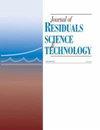响应面法优化酿酒酵母菌生物量对Cd (II)的吸收
引用次数: 3
摘要
本研究采用响应面法(RSM)优化酿酒酵母生物量对Cd (II)的吸收,建立了酿酒酵母生物量对Cd (II)吸收能力的预测模型,方差分析表明该模型具有显著性。在Cd (II)浓度为30 mg/L、生物量为0.8 g/L、温度为28.57°C、pH为5.51、接触时间为3.0 h的条件下,利用期望函数预测其最大吸收容量为22.05 mg/g。Langmuir方程和Freundlich方程都适用于描述生物吸附等温线。本文章由计算机程序翻译,如有差异,请以英文原文为准。
Application of Response Surface Methodology (RSM) for Optimization of Cd (II) Uptake by Saccharomyces Cerevisiae Biomass
In present study, Response Surface Methodology (RSM) was used to optimize Cd (II) uptake by Saccharomyces cerevisiae biomass, the prediction model for Cd (II) uptake capacity using S. cerevisiae biomass was developed, and the analysis of variance (ANOVA) implied the model was significant. The maximum absorbing capacity of 22.05 mg/g was predicted at 30 mg/L Cd (II), 0.8 g/L biomass, 28.57°C, pH 5.51 and 3.0 h of contact time using the desirability function. Both Langmuir and Freundlich equations are suitable for describing biosorption isotherm.
求助全文
通过发布文献求助,成功后即可免费获取论文全文。
去求助
来源期刊

Journal of Residuals Science & Technology
环境科学-工程:环境
自引率
0.00%
发文量
0
审稿时长
>36 weeks
期刊介绍:
The international Journal of Residuals Science & Technology (JRST) is a blind-refereed quarterly devoted to conscientious analysis and commentary regarding significant environmental sciences-oriented research and technical management of residuals in the environment. The journal provides a forum for scientific investigations addressing contamination within environmental media of air, water, soil, and biota and also offers studies exploring source, fate, transport, and ecological effects of environmental contamination.
 求助内容:
求助内容: 应助结果提醒方式:
应助结果提醒方式:


